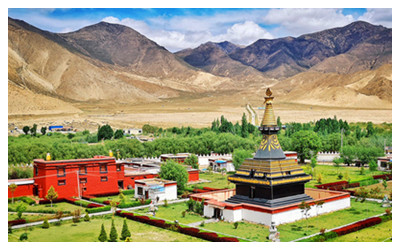
Samye Monastery, situated in the quiet piedmont area of the Shannan Prefecture in Tibet Region, is the first monastery built in Tibet and the first complete with the three Buddhist jewels of Buddha, Dharma and Sangha. With these unique features, this splendid monastery has become an attraction for visitors from near and far.
Built by the Trisong Detsen (reigned 742-798) of the Tubo Kingdom, Samye Monastery was was presided over by the Buddhist master Padmasambhava. The Detsen contributed a lot to the project. First, it was said the name (meaning surprise in
Tibetan) originated from an exclamation he made. When Samye Monastery was completed, Detsen took part in the foundation ceremony and then ordained seven descendants of blue blood to cultivate in the monastery. They became the first group of monks to live at the monastery and later the so-called 'Seven Enlighten Disciples of Samye'. Since then, Buddhism had become widespread within Tibet and forms a branch of splendid culture. Now, the monastery is listed as one of the cultural relics of national importance under the protection of the state.
Being very grandiose and complicated, the Samye Monastery replicates the universe described in the sutras exactly. The central world Mount Meru is represented by the majestic Wuzi Hall. The Sun and Moon chapels stand in the north and south as the sun and moon in the universe. Four larger halls and eight smaller halls are distributed around all sides of the central hall, symbolizing the four large continents and eight small ones. In the four corners lie the Red, White, Black and Green Pagodas guarding the Dharma like the Heavenly Kings. A circular wall surrounds the monastery as if marking the periphery of the world. The layout of Samye Monastery resembles the Mandala in the Esoteric Buddhism.
Samye Monastery is renowned for the characteristic art of its buildings and the vivid murals as well as other ancient relics stored within them.
The three-story Wuzi Hall is the soul of the whole monastery. Its design is very special. All of the layers follow different styles, the bottom
Tibetan, the middle
Han and the top Indian. Hence the monastery is also called the 'Three-styled Temple'. There are also many substantial murals here. On the porch of the middle story is inscribed the reputed 'Painted Historical Records' of Tibet, which extend 9.2 m (10 yd) and contains the religious history of Tibet as well as many related legends. Besides these, the murals depicting the 'Historical Records of Samye Monastery' and the 'Biography of Padmasambhava' on the other two levels are also of high aesthetic value.
Four gates to the Wuzi Hall: The eastern gate leads to the front entrance of the hall. In front of the gate is a nine-story hall, however, only three stories remain standing. On the January 5 and May 16 of the Tibetan Calendar, the large embroidery of Sakyamuni is hung on the wall for people to make homage to, hence the name 'Zhanfo Dian' (Buddha Unfolding Hall). There is also an ancient stele and a bell made during the
Tang Dynasty (618-907) along with a pair of stone lions. On the stele Trisong Detsen's edicts for establishing Buddhism as the state religion in 779 are recorded. The bell was the first one made in
Tibetan history and is said to memorize the third concubine of the Detsen who led 30 aristocratic women to renounce the world and who later became the first group of nuns in
Tibet.
Travel Tips
Add: in the quiet piedmont area of the Shannan Prefecture in Tibet Region
Entrance Fees: Cny 40
Opening Hours: 09:00-18:00
 Samye Monastery, situated in the quiet piedmont area of the Shannan Prefecture in Tibet Region, is the first monastery built in Tibet and the first complete with the three Buddhist jewels of Buddha, Dharma and Sangha. With these unique features, this splendid monastery has become an attraction for visitors from near and far.
Samye Monastery, situated in the quiet piedmont area of the Shannan Prefecture in Tibet Region, is the first monastery built in Tibet and the first complete with the three Buddhist jewels of Buddha, Dharma and Sangha. With these unique features, this splendid monastery has become an attraction for visitors from near and far. Ask Questions ?
Ask Questions ?